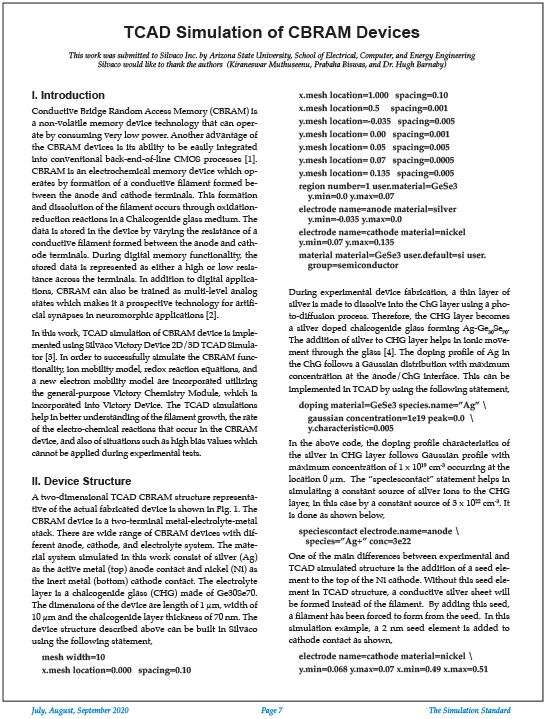TCAD Simulation of CBRAM Devices
I. Introduction
Conductive Bridge Random Access Memory (CBRAM) is a non-volatile memory device technology that can operate by consuming very low power. Another advantage of the CBRAM devices is its ability to be easily integrated into conventional back-end-of-line CMOS processes [1]. CBRAM is an electrochemical memory device which operates by formation of a conductive filament formed between the anode and cathode terminals. This formation and dissolution of the filament occurs through oxidationreduction reactions in a Chalcogenide glass medium. The data is stored in the device by varying the resistance of a conductive filament formed between the anode and cathode terminals. During digital memory functionality, the stored data is represented as either a high or low resistance across the terminals. In addition to digital applications, CBRAM can also be trained as multi-level analog states which makes it a prospective technology for artificial synapses in neuromorphic applications [2]. In this work, TCAD simulation of CBRAM device is implemented using Silvaco Victory Device 2D/3D TCAD Simulator [3]. In order to successfully simulate the CBRAM functionality, ion mobility model, redox reaction equations, and a new electron mobility model are incorporated utilizing the general-purpose Victory Chemistry Module, which is incorporated into Victory Device. The TCAD simulations help in better understanding of the filament growth, the rate of the electro-chemical reactions that occur in the CBRAM device, and also of situations such as high bias values which cannot be applied during experimental tests.
II. Device Structure
A two-dimensional TCAD CBRAM structure representative of the actual fabricated device is shown in Fig. 1. The CBRAM device is a two-terminal metal-electrolyte-metal stack. There are wide range of CBRAM devices with different anode, cathode, and electrolyte system. The material system simulated in this work consist of silver (Ag) as the active metal (top) anode contact and nickel (Ni) as the inert metal (bottom) cathode contact. The electrolyte layer is a chalcogenide glass (CHG) made of Ge30Se70. The dimensions of the device are length of 1 μm, width of 10 μm and the chalcogenide layer thickness of 70 nm.



